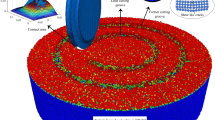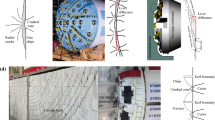Summary
The understanding of rock breaking and chipping due to the TBM cutter disks mechanism in deep tunnels is considered in this paper. The interest stems from the use of TBMs for the excavation of long Trans-Alpine tunnels. Some tests that simulate the disk cutter action at the tunnel face by means of an indenter, acting on a rock specimen are proposed. The rock specimen is confined through a flat-jack and a confinement-free area on one side of the specimen simulates the formation of a groove near the indenter, like it occurs in TBM excavation conditions. Results show a limited influence of the confinement stress versus the thrust increment required for breaking the rock between the indenter and the free side of the specimen. Numerical modelling of the cutter disk action on confined material has also been carried out in order to investigate further aspects of the fracture initiation. Also in this case the importance of the relative position between disk cutter and groove is pointed out.
Similar content being viewed by others
References
N. Barton (2000) TBM tunnelling in jointed and faulted rock Balkema Rotterdam
Bordet, C., Comes, G. (1975): Etude prévisionnelle de la forabilité des roches au tunnelier. Tunnels et Ouvrages Souterrains 7.
N. G. W. Cook M. Hood F. Tsai (1984) ArticleTitleObservations of crack growth in hard rock loaded by an indenter Int. J. Rock Mech. Min. Sci. Geomech. Abstr. 21 IssueID2 97–107 Occurrence Handle10.1016/0148-9062(84)91177-X
G. L. Dollinger H. J. Handewith C. D. Breeds (1999) ArticleTitleUse of punch test for estimating TBM performance Tunnelling Underground Space Technol. 13 IssueID4 403–408 Occurrence Handle10.1016/S0886-7798(98)00083-2
Gaye, F. (1972): Efficient excavation. Tunnels Tunnelling 4(1), 39–48 and 4(2), 135–143.
Gehring, K. (1995): Design criteria for TBM’s with respect to real rock pressure. In: Proc., Tunnel Boring Machines: trends in design and construction of mechanized tunnelling. Hagemberg, 43–53.
H. L. Hartman (1959) ArticleTitleBasic studies of percussion drilling Trans. Am. Min. Engn. 214 68–75
Innaurato, N., Oreste, P. P. (2000): L’interazione utensile-roccia nelle macchine di scavo per roccia. In: Barla, G. (ed.) VIII ciclo di Conferenze di Meccanica ed Ingegneria delle Rocce. Torino, Dec. 2000, 111–158.
Innaurato, N., Oreste, P. P. (2001): Theoretical approach for assessment of the mechanics of rock failure in the TBMs tools-rock interaction. In: Proc., AITES – ITA World Tunnel Congress 2001, Progress in Tunnelling after 2000, Milan (Italy). Patron, Bologna, 227–236.
Innaurato, N., Oggeri, C., Oreste, P. P. (2001): Performance and modelling of indenters and cutting tools for the Assessment of the borability in rock tunnelling. In: Sarkka, P., Eloranta, P. (eds.) Proc., Eurock Symposium Rock Mechanics, a Challenge for Society, 573–578.
International Society for Rock Mechanics (1978): Commission on Standardization of Laboratory and Field Tests. Suggested methods for determining the unaxial compressive strength and deformability of rock materials. Committee on Laboratory tests, Document No. 8.
Klein, S., Schmoll, M., Avrey, T. (1995): TBM performance at four hard rock tunnels in California. In: Proc., RETC, San Francisco, 61–65.
S. Q. Kou P. A. Lindqvist C. A. Tang X. H. Xu (1999) ArticleTitleNumerical simulation of the cutting of inhomogeneous rocks Int. J. Rock Mech. Min. Sci. Geomech. Abstr. 36 IssueID5 711–717 Occurrence Handle10.1016/S0148-9062(99)00039-X
P. A. Lindqvist L. Hai-Hui (1983) ArticleTitleBehaviour of the crushed zone in rock indentation Rock Mech. Rock Engng. 16 199–207 Occurrence Handle10.1007/BF01033280
W. C. Maurer J. S. Rinehart (1960) ArticleTitleImpact crater formation in rock J. Appl. Physics 31 7 Occurrence Handle10.1063/1.1735814
T. Movinkel O. Johannesen (1986) ArticleTitleGeological parameters for hard rock tunnel boring Tunnels Tunnelling 18 IssueID4 45–48
Y. Nishimatsu (1972) ArticleTitleThe mechanics of rock cutting Int. J. Rock Mech. Min. Sci. Geomech. Abstr. 9 IssueID2 261–270 Occurrence Handle10.1016/0148-9062(72)90027-7
T. Szwedzicki (1998) ArticleTitleIndentation hardness testing of rock Int. J. Rock Mech. Min. Sci. 35 IssueID6 825–829 Occurrence Handle10.1016/S0148-9062(97)00334-3
Tarkoy, P. J., Marconi, M. (1991): Difficult rock comminution and associated geological conditions. In: Proc., 6th Congress Tunnelling 91, IMM, London, 195–207.
Thiercelin, M. (1989): Parameters controlling rock indentation. In: Proc., Rock at great depth. Balkema, Rotterdam, 85–92.
S. Timoshenko J. N. Goodier (1951) Theory of elasticity McGraw Hill New York
J. K. Wang T. F. Lehnoff (1976) ArticleTitleBit penetration into rock – a finite element study Int. J. Rock Mech. Min. Sci. Geomech. Abstr. 13 IssueID1 11–16 Occurrence Handle10.1016/0148-9062(76)90222-9
Author information
Authors and Affiliations
Rights and permissions
About this article
Cite this article
Innaurato, N., Oggeri, C., Oreste, P. et al. Experimental and Numerical Studies on Rock Breaking with TBM Tools under High Stress Confinement. Rock Mech. Rock Engng. 40, 429–451 (2007). https://doi.org/10.1007/s00603-006-0109-4
Received:
Accepted:
Published:
Issue Date:
DOI: https://doi.org/10.1007/s00603-006-0109-4




